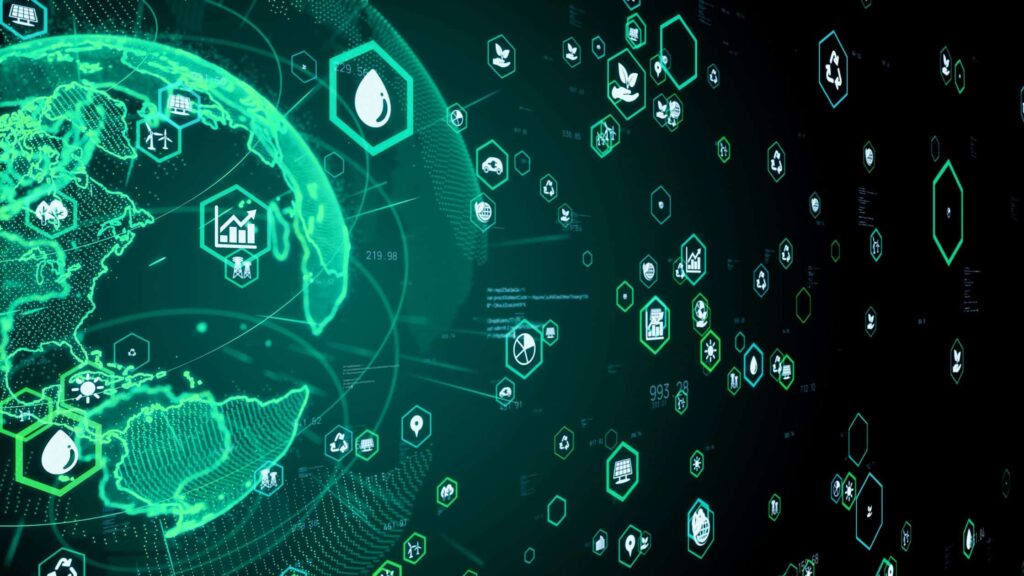5 ways how manufacturers can use digital twins for sustainability

As the world goes digital, manufacturers are constantly looking for innovative solutions to improve productivity and support the green transition. Digital twins are one of the key technologies that have been identified as a solution to these challenges.
In fact, more than half (57%) of organisations believe that digital twin technology is essential to improving sustainability and the green transition, according to a Capgemini survey conducted last year. In addition, more than a third (34%) of the organizations surveyed reported that they have successfully deployed digital twin technology on a large scale to understand and predict energy use and environmental impact. The survey results reflect a growing trend of companies wanting to deliver on their sustainability promises.
In this blog post, we look at five ways manufacturers like you can use the digital twin to promote sustainability. By creating a virtual replica of physical machines and processes, manufacturers can gain valuable insights, streamline operations and make informed decisions that drive sustainable development initiatives. Want to learn how? Keep reading.
5 ways how to use digital twins for sustainability
1. Enhanced resource utilization
One of the main advantages of digital twins is their ability to analyze and optimize the use of materials. By analyzing real-time data from sensors in your machinery and other systems, you can identify inefficient areas such as excessive material consumption or overuse of resources. With this information, you can streamline processes, reduce waste and optimize resource allocation.
2. Optimized energy consumption
Energy costs are often a significant part of a manufacturer’s costs. Digital twins help identify energy-intensive areas of the production line and provide information on how to optimize energy consumption. By analyzing different scenarios and the impact of different variables, you can determine the most energy-efficient approaches and change processes accordingly. This not only reduces operating costs, but also contributes to your sustainability building practices by reducing unnecessary energy use.
3. Predictive maintenance to reduce the time needed for maintenance shutdowns
Unplanned maintenance outages often lead to a waste of resources: raw materials, labour, energy and so on. By monitoring real-time data from machine sensors and applying machine learning algorithms, digital twins can provide early warnings of problems that threaten production, allowing maintenance managers and staff to proactively schedule maintenance. This reduces the risk of unplanned maintenance outages, prevents unnecessary waste of resources and extends the life of equipment.
4. Optimized waste management
One of the main challenges in achieving the sustainability goals is to improve waste management and recycling practices. Many manufacturers report that the recycling process is often inefficient and lacks accurate data on which to base informed decision-making.
With digital twin technology, manufacturers now have a powerful tool to streamline recycling processes and reduce their environmental footprint. By integrating sensors and IoT devices into the recycling infrastructure, valuable information can be collected, such as recycling bin fill rates, sorting efficiency and material composition.
5. Optimizing production to improve worker safety and sustainability
The digital twins allow you to analyze and optimize processes such as production, logistics and supply chain management. By analyzing data from the digital twin, you can identify bottlenecks, optimize workflows and reduce waste. This not only increases sustainability by reducing resource consumption, but also improves overall reliability and safety.

Make data-driven decisions with the digital twin
One of the main benefits of using the digital twin in production is the ability to make intelligent, informed decisions. The vast amount of data generated and collected by the digital twin gives you access to data and insights that help you optimize processes, reduce waste and improve sustainability while saving money.
In the context of sustainability and the green transition, digital twins play a crucial role in enabling you to make environmentally conscious decisions. By analyzing real-time data and different scenarios, you can identify opportunities to optimize energy and resources, ultimately reducing the carbon footprint of your factory.
With the global shift towards a greener economy, adopting digital twins in manufacturing will be essential for all industrial companies that want to meet sustainability targets, cope with the challenges of the green transition and ensure compliance with their ESG goals.
Want to learn more about how you can use digital twins in the green transition? Join us at the Technology 23 exhibition taking place at Messukeskus, Helsinki Expo and Convention Centre. At 12:40pm on Wednesday, November 8th, Jani Akkila, CEO of Process Genius, and Martti Mäkinen, Director of Enterprise Sales will be unveiling how digital twins are enabling green transition in the manufacturing sector at the Tivia stage. Welcome!